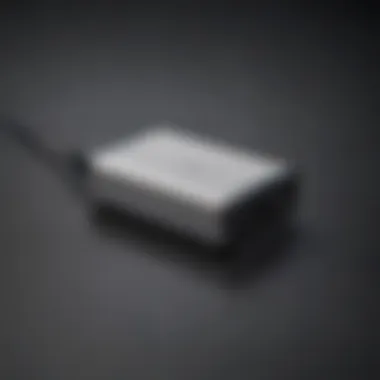Understanding the Apple Charger Adapter: A Comprehensive Guide


Product Overview
The Apple charger adapter is an integral component for anyone using Apple's range of products. Ranging from iPhones to MacBooks, having the right adapter is crucial for maintaining charge efficiency and device compatibility.
Foreword to the Apple Product Being Discussed
Apple has released several models of charger adapters, each designed for different functionalities and devices. From the compact 5W adapter suitable for iPhones to the robust 67W adapter for MacBook Pro, these adapters serve distinct purposes based on power requirements.
Key Features and Specifications
Each charger adapter comes equipped with specific features tailored for optimal functionality. For instance, the 20W USB-C Power Adapter is designed to provide faster charging for compatible devices, while the 30W adapter supports both iPad and MacBook use. The pros of these adapters include slim design, portability, and energy efficiency.
- Wattage Options: Varied from 5W to 140W.
- Compatibility: Adaptability across devices, enabling charging for smartphones, tablets, and laptops.
- Safety Features: Built-in safeguards to prevent overcharging and overheating.
Design and Aesthetics
Apple’s aesthetic approach reflects in the design of their charger adapters. With minimalist designs and smooth finishes, they seamlessly integrate into the Apple ecosystem. The color choices typically match with Apple devices, maintaining a consistent brand look.
Performance and User Experience
When it comes to performance, Apple’s charger adapters are known for reliability. This segment will delve into what users can expect regarding charging speed and efficiency.
Performance Benchmarks
Testing reveals that the 20W adapter can charge an iPhone 12 up to 50% in 30 minutes. On the other hand, a 61W adapter charges a MacBook Air to 100% in approximately 2 hours. These benchmarks emphasize the importance of wattage based on device need.
User Interface and Software Capabilities
Most Apple charger adapters do not have user interfaces in the traditional sense. However, devices like the MacBook phenomenally manage power thanks to software optimization, ensuring the device draws only the necessary energy from the adapter.
User Experiences and Feedback
Feedback from users highlights satisfaction with performance, particularly in speed. However, some users express frustrations with the lack of included cables with certain adapters, implying an additional expense.
Comparison with Previous Models or Competitors
In this section, an analysis of the evolution of Apple’s charger adapters and their competition will be presented.
Advancements and Improvements from Previous Models
Apple has made remarkable strides with each generation of charger adapters. The shift to USB-C in newer models allows for universal compatibility and faster charging capabilities compared to older USB-A variants.
Competitive Analysis with Other Similar Products
Comparatively, brands like Samsung and Anker offer alternatives that sometimes match or exceed Apple's performance. However, Apple's proprietary design, coupled with harmonious integration with its devices, provides distinct advantages.
Value Proposition
While Apple chargers may command higher prices, the premium is often justified through reliability, design quality, and integrated safety features.
Tips and Tricks
To maximize the potential of Apple charger adapters, users should consider the following.
How-to Guides and Tutorials for Optimizing the Apple Product's Performance
For optimal performance:
- Always use the recommended power adapter for each device.
- Avoid exposure to extreme temperatures when charging.
Hidden Features and Functionalities
One feature not widely known is the adaptive charging technology, which adjusts based on the device’s requirements. This ensures efficiency and can extend battery lifespan.
Troubleshooting Common Issues
If you encounter slow charging speeds, ensure the adapter is compatible with your device and check for any debris in the port that might affect connectivity.
Latest Updates and News
Staying abreast of the latest information shapes users' understanding of the Apple ecosystem. Recent developments include changes in firmware that enhance charging efficiency.
Recent Developments in Software Updates and New Features


Apple occasionally rolls out updates that optimize battery performance when using its chargers. Ensure your device is always up-to-date for the best experience.
Industry News and Rumors Surrounding Upcoming Products
Rumors suggest that future adapters may feature improved eco-friendliness in materials and construction, reflecting Apple's commitment to sustainability.
Events and Announcements from Apple
Keep an eye out for Apple's annual product launch events, where advancements in their charging technology may be discussed.
Prolusion to the Apple Charger Adapter
The Apple charger adapter serves as a fundamental component of the Apple ecosystem. As devices become more advanced, the importance of having a reliable charging solution cannot be overstated. For many users, the charger adapter is often overlooked until a power issue arises. This can lead to frustrating experiences, particularly for those who rely on their devices for work or personal use.
The role of the Apple charger adapter extends beyond mere functionality. It is designed to provide safety and optimal performance while charging, accommodating the specific needs of various Apple products. The complexity of charging technology means that understanding the capabilities and specifications of your charger adapter is crucial.
Key considerations include:
- Compatibility: Not all adapters work with every device. It's essential to ensure that the adapter matches the device's requirements to avoid damage or inefficient charging.
- Wattage: Charging speed varies by adapter, influencing how quickly devices charge. Knowing the wattage helps users make informed decisions.
- Design Philosophy: Apple’s approach to charger design has evolved alongside its products. Each iteration introduces improvements that factor in user experience and electrical safety.
A well-informed user can prevent potential issues and maximize the lifespan and efficiency of their adapter. Thus, exploring the intricacies of the Apple charger adapter is beneficial, equipping users with the information necessary to enhance their overall experience with Apple devices.
The Evolution of Apple's Charging Technology
The landscape of charging technology within the Apple ecosystem has undergone significant transformations over the years. Understanding this evolution is crucial for comprehending not just the current hardware but also the rationale behind the design choices and compatibility issues that users often face today. Each advancement has aimed to enhance user experience, improve efficiency, and adapt to changing technological imperatives. With the continual push towards a more streamlined and universally compatible charging experience, Apple's journey reflects broader trends within the tech industry.
From 30-Pin to Lightning Connectors
Originally, Apple utilized the 30-pin connector, which served as the standard interface for a variety of devices, including iPods, iPhones, and iPads. This connector, with its numerous pins, offered a range of functionalities, facilitating audio output, data transfer, and charging in a single cable.
However, the device market began to shift towards more compact and efficient designs. Recognizing this external pressure, Apple launched the Lightning connector in 2012. The Lightning connector marked a notable reduction in size. It supported reversible plug orientation, enhancing ease of use. The switch to Lightning was not merely aesthetic; it increased data transfer speed while reducing interferences. This move set a new benchmark, arguably edging out competitors during its introduction period.
The Lightning connector not only made devices sleeker but it also paved the way for a whole ecosystem of accessories that leveraged this new interface. As seen with the extensive range of Lightning-compatible accessories available, this adaptability was crucial for consumer acceptance.
Transition to USB-C: A Paradigm Shift
In recent years, Apple has shifted its focus towards USB-C as a universal standard. This decision reflects broader industry trends where compatibility and efficiency are paramount. USB-C presents several advantages over prior technologies. For starters, it is a highly versatile connector, providing enhanced data transfer speeds and higher power delivery capabilities, making it suitable for a wide range of devices—from smartphones to laptops.
USB-C also adheres to a more universal model. Many manufacturers have adopted it, thereby reducing the need for multiple cables and connectors across different devices. This convergence helps streamline user experiences and minimizes cable clutter, a significant consideration in today's tech-savvy households.
Furthermore, the USB-C’s capability of carrying both power and data simultaneously grants its use in fast charging technologies. Apple’s transition to adopting USB-C, especially in their iPad and Mac product lines, signifies a major shift, aligning with the broader move towards unifying device charging solutions.
"The introduction of USB-C not only aligns Apple with industry standards but also enhances user convenience across various platforms."
In closing, the evolution of Apple's charging technology is a testament to the company's response to user needs and technological trends. By examining the transition from 30-pin to Lightning and now to USB-C, consumers and tech enthusiasts can gain insights into Apple's strategy for adapting to an ever-changing technological landscape. Understanding these changes is vital for anyone looking to make informed choices regarding accessory purchases and device compatibility.
Types of Apple Charger Adapters
Understanding the types of Apple charger adapters is crucial for users who wish to maximize their device's performance. The right type of adapter can ensure efficient charging and prolong the life of both the device and the adapter itself. Identifying the specific needs based on usage scenarios can inform consumers' choices, allowing them to benefit from the unique attributes each type offers.
In general, there are three prominent categories of Apple charger adapters. Each serves distinct purposes, catering to different user environments and requirements. A thorough comprehension of these types allows users to make informed decisions that align with their technological lifestyle.
Standard Wall Adapters
Standard wall adapters from Apple, such as the 20W USB-C Power Adapter, are designed for home or office use. These adapters are the most common, providing reliable power by simply plugging into a wall outlet. They come in various wattages, allowing for flexibility depending on the device being charged. Using an adapter with a higher wattage than recommended by Apple can lead to faster charging, but it's essential to match or align with device specifications to avoid any potential risk.
These wall adapters often have built-in safeguards that protect devices from overheating and overcharging. This is a major benefit, as safety is paramount when it comes to electronics. For instance, the 30W USB-C Power Adapter is ideal for devices like the MacBook Air, providing the necessary power without the risk of damaging the battery over time.
Key Features of Standard Wall Adapters:
- Various wattages available.
- Built-in safety mechanisms for protection.
- Ideal for stationary uses at home or office.
- Compatible with a range of Apple devices.
Portable Power Adapters
Portable power adapters, including options like the Apple 20W USB-C Power Adapter, offer convenience for on-the-go users. These adapters are compact and lightweight, making them easy to carry in a backpack or purse. They are especially beneficial for travelers who might need to charge their devices in various locations.
These adapters usually do not compromise on performance. They provide efficient charging, similar to standard wall adapters, but with added portability. Users should verify the power output to ensure compatibility with specific devices, as not all portable chargers deliver the same charging speeds. In scenarios where users depend heavily on their devices, a reliable portable power adapter becomes crucial.
Benefits of Portable Power Adapters:
- Lightweight and compact design.
- Versatile use in different settings.
- Efficient charging capabilities.
- Great for travel or commuting.
Third-Party Alternatives
Third-party alternatives to Apple chargers can sometimes offer cost-effective solutions without sacrificing quality. Brands like Anker and Belkin create products that meet or even exceed Apple's specifications. However, caution is warranted when opting for these alternatives, as not all products guarantee the same level of safety or performance.


When considering third-party chargers, consumers should look for compatibility with their specific Apple device requirements. It’s also essential to check for certifications like UL or MFi (Made for iPhone/iPad) which can act as a promise of safety and performance. Using an uncertified adapter may pose risks of damage not only to the adapter but also to the device being charged.
Considerations for Third-Party Adapters:
- Ensure compatibility with Apple devices.
- Look for safety certifications.
- Review user feedback and ratings for quality assessment.
- Be cautious of cheaper models that may lack performance.
Understanding these types of Apple charger adapters enables users to select the right accessory for their charging needs. Making a well-informed choice from standard wall adapters, portable options, or reliable third-party alternatives can significantly enhance the user experience.
Specifications and Compatibility
Understanding the specifications and compatibility of Apple charger adapters is crucial for users seeking optimal performance from their devices. Charging adapters are not a one-size-fits-all solution, and recognizing the unique characteristics of each adapter can enhance the overall user experience. This section will delve into the wattage, charging speed, and compatibility with various devices to clarify the complexities and aid in making informed decisions.
Wattage and Charging Speed
In the realm of charging technology, wattage plays a pivotal role in determining how quickly a device can recharge. Each Apple charger adapter is rated for a specific wattage. For instance, the 20W USB-C Power Adapter is commonly used with iPhones and provides fast charging capabilities for compatible models. Conversely, Apple’s 87W and 96W adapters are designed for the MacBook Pro, accommodating a higher power requirement.
The relationship between wattage and charging speed is straightforward: a higher wattage means faster charging, as long as the device can accept that power. However, users should note that devices have their own limitations. For example, even if a user connects a device to a 96W adapter, if the device only supports 20W, it will not charge any faster than that. This potential mismatch emphasizes the importance of using adapters that meet the specific charging requirements of each device.
Device Compatibility: A Detailed Analysis
Device compatibility is another essential aspect of understanding Apple charger adapters. Not all adapters are compatible with every Apple product, which can lead to frustration. Here is a detailed look at compatibility across various devices:
- iPhones: Most modern iPhones support a broad range of charging options. For best performance, it is advisable to use an adapter that is at least 18W. Typically, new iPhone models come with a 20W adapter, promoting fast charging.
- iPads: iPads generally require higher wattage compared to iPhones. For instance, an iPad requires at least a 20W adapter for effective charging, although options like the 30W adapter can further improve charging times.
- MacBooks: Charging MacBooks necessitates even more power. The 61W, 87W, or 96W adapters are specifically designed for different MacBook models. Using an underpowered adapter can result in slow charging or no charging at all.
- Accessories: Various accessories such as the Apple Watch and AirPods have their unique charging needs. The Apple Watch, for example, typically charges well with a 5W adapter although it comes with a dedicated charger.
Determining compatibility extends beyond simply matching devices with appropriate adapters. It is also vital to consider cable types. The transition from the 30-pin connector to Lightning and now USB-C connectors influences compatibility. As newer models are released, existing users must adapt and sometimes invest in new cables or adapters to ensure seamless charging.
"Proper understanding of wattage and compatibility ensures that you maximize the efficiency of your Apple devices, preventing potential damage and enhancing their lifespan."
When selecting an Apple charger adapter, users should prioritize both device requirements and the specifications of the adapter itself. This knowledge can eliminate misunderstandings and empower users in their tech interactions.
Understanding Regulatory Compliance
In the realm of electrical devices, understanding regulatory compliance is crucial. When it comes to Apple charger adapters, compliance ensures both safety and environmental stewardship. Various standards govern how these adapters are manufactured, tested, and utilized. This section discusses key aspects of regulatory compliance, emphasizing the significance it holds for consumers and manufacturers alike.
Safety Standards for Apple Adapters
Safety standards are essential as they protect users from potential hazards associated with electrical devices. Organizations like Underwriters Laboratories (UL) set guidelines that Apple’s charger adapters must adhere to before they reach the market. These standards evaluate several factors, including thermal protection, short circuit resistance, and overall product durability. A compliant adapter not only prevents accidents but also enhances consumer confidence.
Some notable safety certifications include:
- UL Certification: Ensures the charger meets rigorous safety standards.
- CE Mark: Indicates conformity with health, safety, and environmental protection standards in Europe.
- FCC Compliance: Ensures that the adapter does not cause harmful interference with other electronic devices.
Adhering to these safety standards allows Apple to maintain a competitive edge while prioritizing user protection. Each adapter that bears these marks implies that it has undergone stringent testing protocols.
Environmental Considerations
Environmental regulations play a pivotal role regarding product lifecycle and sustainability. Apple places a strong emphasis on producing adapters that are not only effective but also comply with relevant environmental laws. These include directives concerning hazardous materials, recyclability, and energy efficiency. For instance, the WEEE (Waste Electrical and Electronic Equipment) directive addresses the responsible disposal of electronic waste, encouraging users to return old devices for eco-friendly recycling.
Considerations such as:
- Restricting Hazardous Substances (RoHS): Limits the use of specific hazardous materials in electrical and electronic equipment.
- Energy Star Certification: Identifies energy-efficient products, reducing the carbon footprint associated with manufacturing and use.
- Recyclability: The design and materials of the adapter should allow for efficient recycling processes.
By committing to environmental compliance, Apple can reduce the impact of its adapters on the planet, aligning with the growing consumer demand for sustainable products. This, in turn, fosters a positive brand image and encourages responsible consumption practices.
An informed user can make better choices about the products they use, impacting overall safety and environmental standards in the tech industry.
Common Issues and Troubleshooting
In the realm of technology, understanding common issues and their solutions is crucial. This section addresses the typical problems users experience with Apple charger adapters and offers troubleshooting steps to resolve them.
Ensuring your devices maintain optimal performance is essential, particularly as reliance on technology continues to deepen across personal and professional domains. Encountering charging problems can lead to frustration and wasted time. Therefore, it is beneficial to know how to troubleshoot these issues effectively. Additionally, recognizing when an adapter shows signs of wear and tear can help extend its lifespan and optimize performance.
Charging Problems: Causes and Solutions
Charging problems can manifest in several ways, from slow charging to complete failure to charge. Identifying the specific cause of the issue is critical for implementing the right solution.
- Faulty Cable: The charging cable is often the first culprit. Inspecting it closely for frays or damages is wise. If compromised, replacing the cable may solve the issue.
- Adapter Overheating: If the Apple charger adapter becomes too hot during use, it might stop functioning properly. This could be due to improper ventilation or prolonged usage. Allowing it to cool down can sometimes resolve the problem.
- Outlet Issues: Sometimes, the problem does not stem from the charger or cable. Test the outlet with another device to ensure it is providing power. If not, consider using a different outlet.
- Device Connection Issues: The port on the device may also be dirty or obstructed. Cleaning it gently can restore a solid connection, thus solving the charging problem.
Remember, systematic troubleshooting can often resolve many issues before seeking professional help.
Wear and Tear: When to Replace Your Adapter
Understanding the signs of wear and tear on your charger adapter is essential for maintaining device performance.


- Physical Damage: Signs of cracks or exposed wires indicate a need for replacement. Using a damaged adapter can pose safety risks.
- Charging Inconsistency: If the adapter works intermittently, it may be time to consider a new one. Reliability is key in maintaining device functionality.
- No Longer Compatible: As new devices emerge, adapters may become obsolete. If your Apple device no longer charges with your current adapter, investigate compatibility or seek replacements.
- Wattage Considerations: If you frequently find that your adapter cannot keep up with your device's charging needs, it might be time for an upgrade to a higher wattage model.
In summary, recognizing these wear signs and addressing them promptly can avoid inconveniences and enhance user experience with Apple products.
The Impact of Obsolescence on Apple Products
Obsolescence is an important factor within the tech landscape, and it holds significant relevance for users of Apple products. As new models are released, Apple introduces innovations not just in hardware but also in charging technology. This evolving tech scenario can significantly impact how users interact with their existing devices and accessories, including charger adapters.
How New Models Affect Charging Options
With each new generation of Apple devices, there is typically a shift in charging standards and capabilities. For instance, the transition from 30-pin connectors to Lightning connectors provided a more efficient and compact charging solution. Currently, many newer Apple products move towards USB-C technology. This shift does not only influence compatibility; it can also enhance charging speed and data transfer rates. Users must adjust to these changes, often investing in new adapters or cables to maintain functionality with their devices.
The introduction of advanced models means older devices may face functional obsolescence, where they no longer support the latest charging options. For example, an iPhone model that uses Lightning connectors may require a different adapter if paired with a more recent MacBook that utilizes USB-C. The divergence of charging technologies can lead to frustration for users who need to manage multiple adapters for different devices.
Navigating Compatibility Challenges
Navigating compatibility challenges is crucial for optimizing the user experience with Apple products. As models evolve, ensuring that chargers, cables, and adapters are compatible becomes increasingly complex. Users often find themselves dealing with adapters that do not meet their charging needs. Consider the potential compatibility issues:
- Older adapters may not fit new ports.
- Newer devices may not charge effectively using outdated chargers.
- Third-party accessories may or may not support proprietary standards, leading to variances in performance.
To address these challenges, users should remain informed about the specifications associated with their devices. It is advisable to use Apple-certified adapters and cables to ensure safety and performance. Utilizing community resources, such as forums on Reddit, can also provide insights from other users who faced similar challenges.
"Understanding which charging solutions are compatible can save both time and money in the long run."
Ultimately, keeping abreast of the latest technological shifts will help users navigate the landscape of Apple products more effectively, ensuring they make informed decisions about their charging solutions. Being aware of obsolescence allows users to plan appropriately for future needs, minimizing disruptions to their daily routines.
Practical Tips for Optimal Charging
Proper charging of your Apple devices involves more than just plugging in your adapter. Recognizing the nuances of optimal charging ensures better performance and longevity for your device. Addressing the points discussed in this section arms you with practical knowledge for everyday use. It covers essential aspects such as maintenance of adapters, efficiency in energy usage, and prevents unnecessary wear and tear on the device's battery.
Best Practices for Maintaining Adapter Longevity
To extend the life of your Apple charger adapter, following certain practices is vital. Here are key points to consider:
- Avoid Overheating: Avoid using your adapter in excessively hot environments. Heat can degrade internal components, impacting performance.
- Unplug When Not in Use: Keeping your adapter plugged in without being used can lead to excess heat accumulation. Always unplug when not needed.
- Cables and Connections: Examine your charging cable regularly. Fray or damage in cables can pose risks of short-circuiting. Replace any that show signs of damage.
- Use Genuine Products: Using third-party adapters may seem economical; however, they often lack quality assurance. Apple's adapters meet specific safety standards designed for their products.
- Clean Connections: Dirt and dust can obstruct connections. A gentle wipe of the adapter's prongs and the device’s charging port with a dry cloth can prevent connectivity issues.
Maximizing Charging Efficiency
Efficient charging can significantly enhance your user experience. Here are some strategies:
- Use Appropriate Wattage: Depending on your device, using an adapter that fits its specifications ensures faster and safer charging. For instance, MacBook Pro requires a higher wattage compared to an iPhone.
- Monitor Background Activities: Applications running in the background can slow charging. Consider closing unnecessary applications during charging sessions.
- Charge in Airplane Mode: If immediate use of the device is not required while charging, enabling airplane mode reduces energy consumption, allowing for faster charging.
- Positioning Matters: Avoid placing your device on soft surfaces like beds or couches while it’s charging, as they can trap heat. A flat, hard surface enables better airflow and cooling.
- Optimal Plugging Position: Ensure that the adapter is plugged directly into an outlet rather than using an extension cord. This can prevent voltage fluctuations that may affect charging speed.
"Understanding how to care for your Apple charger adapter not only helps in extending its lifespan but also keeps your device performing optimally."
These practical insights are significant in maintaining the efficiency and longevity of your Apple charger adapters. Making informed charging decisions can save time, improve device performance, and reduce environmental waste.
Future Trends in Charging Technology
The realm of charging technology is ever-evolving, particularly concerning Apple products. The exploration of future trends is integral to understanding how users can adapt to new charging methods while maximizing device performance. As technology progresses, innovations in adapter design and wireless charging fundamentally alter user experience. Anticipating these developments can help consumers make informed decisions and future-proof their tech investments.
Anticipated Developments in Adapter Design
Future designs of Apple charger adapters are likely to focus on efficiency and sustainability. Enhanced compactness will be a priority, aiming to reduce physical space while improving functionality. Here are several anticipated shifts in design:
- Integration of Smart Technology: Future adapters may incorporate smart features such as automatic wattage adjustments. This could optimize charging speeds by adjusting to the device's needs.
- Durable Materials: The trend is shifting towards using materials that resist wear and tear. This will lead to longer-lasting products that can withstand daily usage.
- Multi-Device Charging Solutions: Consumers often own multiple devices. Hence, adapters that can charge several devices at once are bound to gain popularity, improving convenience.
Incorporating these elements would not only enhance performance but also align with user expectations for efficiency.
The Role of Wireless Charging
Wireless charging technology is becoming a significant aspect of how devices power up. Apple's focus on wireless charging aligns with wider trends in the industry. The introduction of MagSafe is an excellent example of how Apple is shaping this space. Here are several considerations regarding the role of wireless charging:
- Convenience: Wireless charging eliminates the hassle of plugging and unplugging cables. Users can simply place their devices on a charging pad, enhancing user convenience.
- Reduced Wear and Tear: Wireless charging can mitigate damage that comes from frequent plug use. This might lead to longer lifespans for both devices and chargers.
- Salvaging Design Aesthetics: As devices become sleeker, integrating wireless charging allows for more streamlined designs without physical ports cluttering the exterior.
Despite the advancements, challenges remain. Wireless charging tends to be slower than wired options, raising questions about efficiency. However, as technology advances, improvements in speed and effectiveness are anticipated.
"The future of charging technology, particularly wireless charging, offers significant potential to transform user experience."
Understanding these trends helps Apple enthusiasts and tech professionals prepare for the future landscape of charging technology, ensuring they stay informed and ready to adapt.
End: Making Informed Decisions
In the realm of technology, particularly when it comes to accessories like the Apple charger adapter, making informed decisions is paramount. Given the rapid evolution of devices and their charging mechanisms, understanding the implications of your choices can lead to enhanced performance and longevity of both your devices and their charging solutions.
One of the primary considerations involves compatibility. Different devices require specific adapter models to ensure optimal charging speed and safety. Mismatching accessories may cause slow charging or, in worst cases, damage the device. As Apple continues to innovate, being aware of your particular device's requirements helps in avoiding frustration down the line.
Furthermore, choosing the right charger adapter involves evaluating wattage and charging speed. Higher wattage generally allows for faster charging. However, it is critical to ensure that your device can handle the increased power. Investing in a charger that aligns with your device’s specifications results in a more efficient charging experience.
Another important aspect is the potential for obsolescence. As technology progresses, older models may become incompatible with new devices or standards. Monitoring Apple's releases and adapting your charging setup accordingly can save both time and money. Staying updated on trends can prevent the need for last-minute purchases that may not align with your actual needs.
"Investing in the correct charger adapter is not just about charging; it’s about safeguarding your investment in technology."



